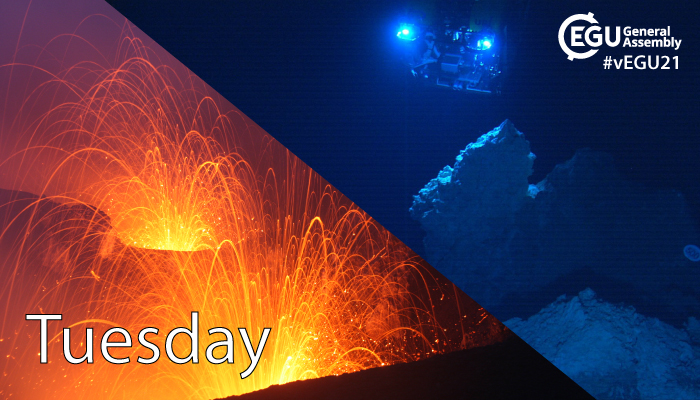
After some technical teething problems on Monday morning (honestly is it even an online conference without technical difficulities?) we’re extra eager to get stuck into some of the amazing science being presented today. As with all the sessions so far, most of the presenters have uploaded display materials to accompany their presentations which range from posters to full length recorded talks, so be sure to check those out!
Kicking things off in the morning is GMPV7.1 Metamorphic minerals: the building blocks of geological paradigms (09:00–12:30 CEST, link). Particularly enticing in this session is Cisneros and Behr’s comparison of novel and conventional barometers (Quartz-in-garnet elastic barometry vs. conventional thermobarometers: a comparison across diverse tectonic settings, EGU21-3822, 09:23–09:25). Those of a more magmatic bent might find solace in Carvalho et al. discussing the extremes conditions at which metamorphism blurs into melting (Generation of highly silicic magmas at ultra-high temperature conditions : evidence from melt inclusions in peritectic garnet, EGU21-2291, 09:27–09:29). Honorable mention must also go to Hinsberg et al. for the only presentation which doubles as a ruthless tongue twister (The corundum conundrum: Constraining the compositions of fluids involved in metasomatic corundum formation, EGU21-10229, 09:25–09:27).
Running concurrently are two other sessions co-organized by GMPV (both 09:00–12:30 CEST). Session GD3.2 Geochemical and geodynamic perspectives on the origin and evolution of deep-seated mantle melts and their interaction with the lithosphere (link), should scratch anyone’s itch to hear about deep melting, carbonatites, kimberlites and all their continental friends. In this vein, Faccini et al.’s presentation, combining volatiles, fluid inclusions and petrology of mantle xenoliths sounds particularly appealing (Combining volatiles measurements in fluid inclusions with petrology of ultramafic xenoliths: new insights on the evolution of the West Eifel and Siebengebirge (Germany) Sub-Continental Lithospheric Mantle, EGU21-13422, 09:46–09:48). Meanwhile in Session SSP1.3, Mass Extinctions, Volcanism, Impacts and Extreme Environmental Changes (link), two presentations on the climate and extinction impacts of large igneous provinces look as fascinating as they are important (Newton et al., Ocean sulfate scarcity as a pre-condition for Large Igneous Province driven mass extinction, EGU21-11189, 09:05–09:07; Capriolo et al., Deep CO2 from the Central Atlantic Magmatic Province during the end-Triassic mass extinction, EGU21-11189, 09:24–09:26).
From the metamorphism and melting of the morning, the afternoon sees us drop the temperature considerably to consider: From the nano- to the orogen-scale: metamorphism, deformation and fluid-rock interaction, Session GMPV6.1 (13:30–17:00 CEST, link). A particular highlight in this session looks to be Aarestad et al. reporting on new experiments aimed at understanding serpentinisation (Feedback mechanisms in mineral replacement networks: an experimental investigation of the ultramafic model system, EGU21-8633, 13:55–13:57) while later in the session, Albers et al. demonstrate just how important a process serpentinisation might be for life (How much energy for life (H2) is generated by serpentinization at passive continental margins? EGU21-1469, 14:07–14:09). If serpentinisation is not your idea of fun (and these talks fail to persuade you) there’s always carbon to get excited about and what better to do that than retrograde carbonation? (Hu et al., Retrograde carbon sequestration in orogenic complexes: a case study from the Chinese Southwestern Tianshan, EGU21-1154, 15:54–15:56)
Meanwhile, in another GMPV co-organized session – GD1.2 Melts and volatiles in Earth and planetary interiors: from atmosphere to core, from global cycles to the micro-scale, from transport dynamics to storage to geophysical detection (15:30–17:00 CEST, link) – presentations on Sulfur isotope evidence of geochemical zonation of the Samoan mantle plume (Dottin et al., EGU21-6416, 15:30–15:40) and Eclogite xenoliths document water cycling at the lithosphere-asthenosphere boundary (Reyned and Hermann, EGU21-5932, 15:48–15:50) stand out as particular highlights.
If you’ve still got energy for more science, first off bravo! Secondly, don’t miss Jussi Heinonen’s short course, Showcasing the Magma Chamber Simulator (SC5.20, 16:00–17:00 CEST). It sounds like a fantastic new tool for all your magma chamber needs, and I for one can’t wait to hear about it.
And that’s it! You’ve made it through another exciting, challenging and, honestly, tiring day of science at vEGU 2021! Go make yourself a nice hot drink (or something stronger), put your feet up and get ready for tomorrow…
